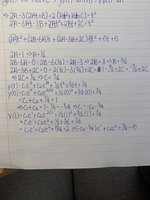You were able to do the problems before #5? The only difference between 4 and 5 is that the equations in #5 are "non-homogeneous". They have a term, f(t), that depends on x only, no Y or derivatives of y.
For linear equations, we can get the general solution the entire equation by adding any one solution of the entire equation to the general solution to the "associated homogeneous equation" (dropping f(x)). So the problem becomes one of find a single solution to the entire equation.
There are two methods of doing that. The simpler is the "method of undetermined coefficients". IF f(t) is "of the kind we expect as solutions to linear des with constant coefficients (polynomials, sine or cosine, exponentials, and multiples of those) which is the case with all problems in #5. Experience with des allows you to guess what kind of function it should be, up to constants.
For example, in (a) \(\displaystyle f(t)= t^2\), a quadratic function, so we try \(\displaystyle y(t)= At^2+ Bt+ C\), the general quadratic. Then \(\displaystyle y'= 2At+ B\) and \(\displaystyle y''= 2At\).
Now put this into the equation, \(\displaystyle \frac{d^2y}{dt^2}- 3\frac{dy}{dt}+ 2y= 2At+ B- 3(2At+ B)+ 2(At^2- 3Bt+ C)= 2At^3+ (-4A- 6B)t- 2B+ 2C= t^2\). In order that two polynomials be the same for all t, the coefficients must be the same: 2A= 1, -4A- B= 0, -2B+ 2C= 0. A= 1/2, -2A- B= 0 so B= -1, and C= B= -1.
The general solution to the associated homogeneous equation, \(\displaystyle \frac{d^2y}{dt^2}- 3\frac{dy}{dt}+ 2y= 0\), which has characteristic equation [tex\r^2- 3r+ 2= (r- 2)(r+ 1)= 0[/tex], is \(\displaystyle y(t)= Ae^{2t}+ Be^{-t}\) so the general solution to the entire equation is \(\displaystyle y(t)= Ae^{2t}+ Be^{-t}+ (1/2)t^2- t- 1\).

